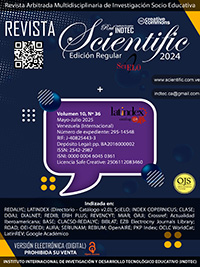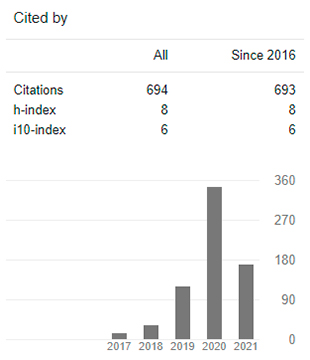Rethinking Education: Epistemological Readings and Critiques of the Contributions of Connectivism as an Educational Model
Repensando la Educación: Lecturas y Críticas Epistemológicas a los Aportes del Conectivismo como Modelo Educativo
DOI:
https://doi.org/10.29394/Scientific.issn.2542-2987.2025.10.36.13.270-293Keywords:
online learning, educational theory, educational technology, learning environments, teaching methodsAbstract
Connectivism presents learning as a process occurring in distributed networks of interconnected nodes, challenging traditional approaches by promoting decentralized environments where educators facilitate learning. Despite its theoretical relevance, questions persist regarding specific characteristics contributing to the educational process. This study explored connectivism characteristics that contribute to teaching and learning through a systematic literature review with a qualitative approach using the PRISMA protocol. A total of 836 articles were identified in Scopus, JSTOR, and ERIC databases, finally selecting 23 studies published between 2013-2023. Results revealed five main characteristics: connected learning environments (52,17%), interactivity (30,43%), autonomy (21,74%), openness (17,39%), and diversity (8,69%). It is concluded that connected learning environments constitute the most relevant characteristic of connectivism, enabling network-based learning and generating collaborative communities. Autonomy and interactivity emerge as fundamental competencies allowing students to manage their own learning networks. These findings establish a theoretical foundation for effective connectivism implementation in contemporary educational contexts, highlighting the need to develop digital competencies and pedagogical strategies that gradually promote these characteristics.
Downloads
References
Bates, T. (2012). What’s right and what’s wrong about Coursera-style MOOCs. United States: Tony Bates.
Borrás-Gené, O., Martínez-Núñez, M., & Martín-Fernández, L. (2019a,b). Enhancing fun through gamification to improve engagement in MOOC. Informatics, 6(28), 1-20, e-ISSN: 2227-9709. Recuperado de: https://doi.org/10.3390/INFORMATICS6030028
Boyraz, S., & Ocak, G. (2022a,b). Are students already connective?. Insights on teaching English through a connective approach. International Journal of Technology in Teaching and Learning, 18(1), 24-45, e-ISSN: 1551-2576. Recuperado de: https://doi.org/10.37120/ijttl.2022.18.1.02
Brown, G., & Foster, C. (2023a,b). The Use of Virtual Learning Environments in Higher Education-Content, Community and Connectivism-Learning from Student Users. In Jahankhani, H., Jamal, A., Brown, G., Sainidis, E., Fong, R., Butt, U. (eds.). AI, Blockchain and Self-Sovereign Identity in Higher Education. Advanced Sciences and Technologies for Security Applications. (pp. 125-142). ISBN: 978-3-031-33627-0. Switzerland: Springer, Cham.
Corbett, F., & Spinello, E. (2020a,b). Connectivism and leadership: harnessing a learning theory for the digital age to redefine leadership in the twenty-first century. Heliyon, 6, 1-9, e-ISSN: 2405-8440. Retrieved from: https://doi.org/10.1016/J.HELIYON.2020.E03250
Danka, I. (2020). Motivation by gamification: Adapting motivational tools of mas-sively multiplayer online role-playing games (MMORPGs) for peer-to-peer as-sessment in connectivist massive open online courses (cMOOCs). International Review of Education, 66, 75-92, e-ISSN: 1573-0638. Retrieved from: https://doi.org/10.1007/S11159-020-09821-6
De la Garza, L., Sancho, T., & Gómez, M. (2015a,b). Indicators of pedagogical quality for the design of a Massive Open Online Course for teacher training. Rusc. Universities and Knowledge Society Journal, 12(1), 104-118, e-ISSN: 1698-580X. Retrieved from: https://doi.org/10.7238/RUSC.V12I1.2260
Downes, S. (2012a,b,c). Connectivism and Connective Knowledge. ISBN: 978-1-105-77846-9. Canada: National Research Council Canada.
Dziubaniuk, O., Ivanova-Gongne, M., & Nyholm, M. (2023a,b). Learning and teaching sustainable business in the digital era: a connectivism theory approach. International Journal of Educational Technology in Higher Education, 20(20), 1-23, e-ISSN: 2365-9440. Retrieved from: https://doi.org/10.1186/S41239-023-00390-W
Fidalgo-Blanco, Á., Sein-Echaluce, M., & García-Peñalvo, F. (2015a,b). Methodological Approach and Technological Framework to Break the Current Limitations of MOOC Model. Journal of Universal Computer Science, 21(5), 712-734, e-ISSN: 0948-6968. Austria: Technische Universität Graz.
Friesen, N., & Lowe, S. (2012). The questionable promise of social media for educa-tion: Connective learning and the commercial imperative. Jcal. Journal of Computer Assisted Learning, 28(3), 183-194, e-ISSN: 1365-2729. Retrieved from: https://doi.org/10.1111/J.1365-2729.2011.00426.X
Hernández, R., Fernández, C., & Baptista, M. (2014). Metodología de la Investigación. Sexta edición, ISBN: 978-1-4562-2396-0. México: McGraw-Hill / Interamericana Editores, S.A. de C.V.
INEE (2018). Ineval presentó resultados de PISA-D. Ecuador: Instituto Nacional de Evaluación Educativa.
Jacobsen, D. (2019). Dropping Out or Dropping In? A Connectivist Approach to Understanding Participants’ Strategies in an e-Learning MOOC Pilot. Technology, Knowledge and Learning, 24, 1-21, e-ISSN: 2211-1670. Retrieved from: https://doi.org/10.1007/S10758-017-9298-Z
Jailani, A., Maulan, S., Mohamad, N., Hoo, J., Yusuf, A., & Rahmat, N. (2023). Exploring Online Learning from Connectivism View. International Journal of Academic Research in Business and Social Sciences, 13(7), 924-937, e-ISSN: 2222-6990. Retrieved from: https://doi.org/10.6007/IJARBSS/v13-i7/17042
Kop, R. (2011a,b). The challenges to connectivist learning on open online networks: Learning experiences during a massive open online course. The International Review of Research in Open and Distributed Learning, 12(3), 19-38, e-ISSN: 1492-3831. Retrieved from: https://doi.org/10.19173/irrodl.v12i3.882
Kop, R., & Hill, A. (2008a,b). Connectivism: Learning theory of the future or vestige of the past?. International Review of Research in Open and Distance Learning, 9(3), 1-13, e-ISSN: 1492-3831. Retrieved from: https://doi.org/10.19173/irrodl.v9i3.523
Langridge, A. (2023). Is Connectivism Viable?. The Interdisciplinary Journal of Student Success, 2, 13-25, e-ISSN: 2817-2221. Canada: CDS Press.
Sánchez, J. (2019). Desarrollo de un entorno digital de aprendizaje desde el Conectivismo y su posterior análisis utilizando algoritmos de machine learning. Edutec. Revista electrónica de tecnología educativa, 69, 1-22, e-ISSN: 1135-9250. España: Asociación para el Desarrollo de la Tecnología Educativa.
Scott, J. (2016). Connectivism: A knowledge learning theory for the digital age?. Medical Teacher, 38(10), 1064-1069, e-ISSN: 0142-159X. Retrieved from: https://doi.org/10.3109/0142159X.2016.1173661
Siemens, G. (2005a,b,c,d). Connectivism: A learning theory for the digital age. International Journal of Instructional Technology & Distance Learning, 2(1), 3-10, e-ISSN: 1550-6908. United States: DonEl Learning, Inc.
Siemens, G. (2006a,b,c). Knowing Knowledge. ISBN: 978-1-4303-0230-8. United States: Lulu Press.
Siemens, G., Rudolph, J., & Tan, S. (2020a,b). “As human beings, we cannot not learn”. An interview with Professor George Siemens on connectivism, MOOCs and learning analytics. Jalt. Journal of Applied Learning & Teaching, 3(1), 108-119, e-ISSN: 2591-801X. Retrieved from: https://doi.org/10.37074/JALT.2020.3.1.15
Techakosit, S., & Wannapiroon, P. (2015). Connectivism Learning Environment in Augmented Reality Science Laboratory to Enhance Scientific Literacy. Procedia - Social and Behavioral Sciences, 174, 2108-2115, e-ISSN: 1877-0428. Retrieved from: https://doi.org/10.1016/J.SBSPRO.2015.02.009
Wong, C., & Ng, D. (2020). The roles of school leaders in developing future-ready learners: The case of Singapore. International Journal of Educational Management, 35(1), 249-269, e-ISSN: 1758-6518. Retrieved from: https://doi.org/10.1108/IJEM-06-2020-0283
Downloads
Published
How to Cite
Issue
Section
License
Copyright (c) 2025 INDTEC, C.A.

This work is licensed under a Creative Commons Attribution-NonCommercial-ShareAlike 4.0 International License.
The content of the journals of this site, are under a Creative Commons Attribution-Noncommercial-Share Alike 4.0 International License.













